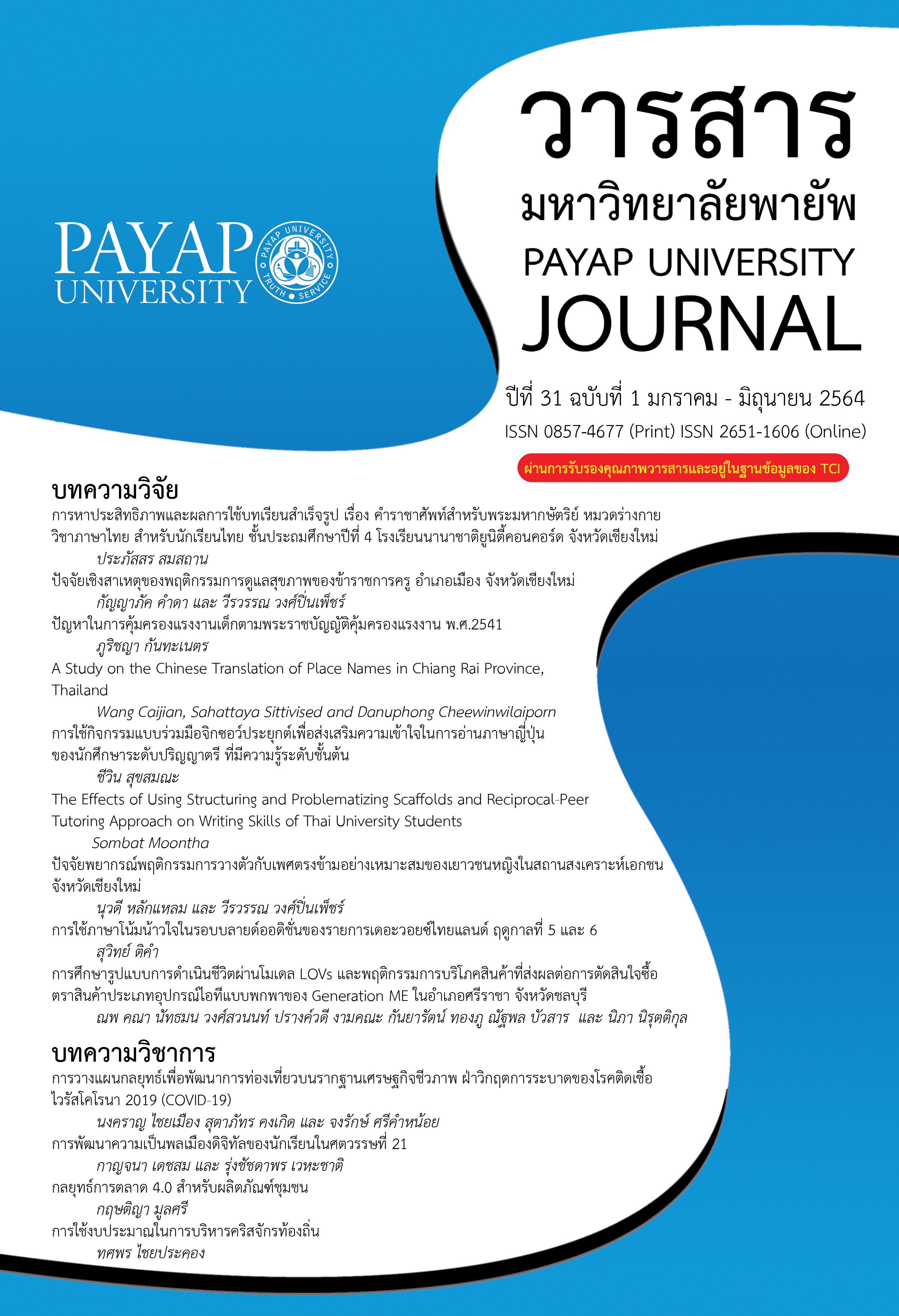การหาประสิทธิภาพและผลการใช้บทเรียนสำเร็จรูป เรื่อง คำราชาศัพท์สำหรับพระมหากษัตริย์ หมวดร่างกาย วิชาภาษาไทย สำหรับนักเรียนไทย ชั้นประถมศึกษาปีที่ 4 โรงเรียนนานาชาติยูนิตี้คอนคอร์ด จังหวัดเชียงใหม่
Main Article Content
บทคัดย่อ
การวิจัยครั้งนี้ เป็นการวิจัยในชั้นเรียน มีวัตถุประสงค์เพื่อ 1) หาประสิทธิภาพของบทเรียนสำเร็จรูปเรื่อง คำราชาศัพท์สำหรับพระมหากษัตริย์ หมวดร่างกาย วิชาภาษาไทย 2) ศึกษาผลการใช้บทเรียนสำเร็จรูปเรื่อง คำราชาศัพท์สำหรับพระมหากษัตริย์ หมวดร่างกาย วิชาภาษาไทย สำหรับนักเรียนไทยชั้นประถมศึกษาปีที่ 4 โรงเรียนนานาชาติยูนิตี้ คอนคอร์ด ประชากรเป้าหมาย มี 2 กลุ่ม คือ กลุ่มนักเรียนสำหรับขั้นตอนการสร้างและหาประสิทธิภาพบทเรียนสำเร็จรูป จำนวน 3 คน และกลุ่มนักเรียนสำหรับขั้นตอนการศึกษาผลการใช้บทเรียนสำเร็จรูป จำนวน 8 คน จากนักเรียนไทยชั้นประถมศึกษาปีที่ 4 โรงเรียนนานาชาติยูนิตี้คอนคอร์ด เครื่องมือที่ใช้ในการวิจัย ได้แก่ 1) บทเรียนสำเร็จรูปเรื่อง คำราชาศัพท์สำหรับพระมหากษัตริย์ หมวดร่างกาย วิชาภาษาไทย สำหรับนักเรียนไทยชั้นประถมศึกษาปีที่ 4 ได้ค่าความสอดคล้องของหลักการและโครงสร้างเนื้อหา มีค่าระหว่าง 0.67 ถึง 1.00 2) แบบทดสอบวัดผลการเรียนรู้ก่อนเรียนและหลังเรียนบทเรียนสำเร็จรูปจำนวน 10 ข้อ ได้ค่าความสอดคล้องของหลักการและโครงสร้างเนื้อหามีค่าระหว่าง 0.67 ถึง 1.00 และค่าความยากง่ายเฉลี่ยทั้งฉบับมีค่าเท่ากับ 0.58 ผลการวิจัยพบว่า 1) ประสิทธิภาพของบทเรียนสำเร็จรูปมีค่าเท่ากับ 92.00/83.33 ซึ่งสูงกว่าเกณฑ์มาตรฐาน 80/80 2) ผลการเรียนรู้ของนักเรียนที่เรียนโดยใช้บทเรียนสำเร็จรูป เรื่อง คำราชาศัพท์สำหรับพระมหากษัตริย์ หมวดร่างกาย วิชาภาษาไทย สำหรับนักเรียนไทยชั้นประถมศึกษาปีที่ 4 โดยก่อนเรียนมีค่าคะแนนเฉลี่ยเท่ากับ 3.63 และหลังเรียนมีค่าคะแนนเฉลี่ยเท่ากับ 8.75 จากคะแนนเต็ม 10 สรุปได้ว่า ผลการเรียนรู้หลังเรียนสูงกว่าก่อนเรียน เป็นคะแนนเฉลี่ยเท่ากับ 5.12
Article Details
เอกสารอ้างอิง
กระทรวงศึกษาธิการ. (2553). หลักสูตรแกนกลางการศึกษาขั้นพื้นฐานพุทธศักราช 2551(พิมพ์ครั้งที่ 3). กรุงเทพฯ: ผู้แต่ง.
กลุ่มโรงเรียนนานาชาติจังหวัดเชียงใหม่. (2555). หลักสูตรภาษาและวัฒนธรรมไทยในโรงเรียนนานาชาติ (หน่วยการเรียนรู้) สำหรับนักเรียนชาวต่างประเทศ. เชียงใหม่: ชมรมโรงเรียนนานาชาติจังหวัดเชียงใหม่.
ชัยยงค์ พรหมวงศ์. (2556). การทดสอบประสิทธิภาพสื่อหรือชุดการสอน. วารสารศิลปากรศึกษาศาสตร์วิจัย, 5(1), 7-20.
ทิศนา แขมมณี. (2552). ศาสตร์การสอน. กรุงเทพฯ: จุฬาลงกรณ์มหาวิทยาลัย.
ธนันท์ลดา วรรณคำ. (2552). การพัฒนาบทเรียนสำเร็จรูปวิชาภาษาไทย เรื่องการเขียนสะกดคำ สำหรับนักเรียนชั้นมัธยมศึกษาปีที่ 3 โรงเรียนสาธิตแห่งมหาวิทยาลัยรังสิต ปทุมธานี. สารนิพนธ์ปริญญาการศึกษามหาบัณฑิต สาขาวิชาการมัธยมศึกษา มหาวิทยาลัยศรีนครินทรวิโรฒ.
นิตยา ผูกเกษร. (2551). การพัฒนาบทเรียนสำเร็จรูปวิชาภาษาไทย เรื่องการอ่านตีความ สำหรับนักเรียนชั้นมัธยมศึกษาปีที่ 4 โรงเรียนเซนต์ฟรังซีสเซเวียร์ นนทบุรี. สารนิพนธ์ปริญญาการศึกษามหาบัณฑิต สาขาวิชาการมัธยมศึกษา มหาวิทยาลัยศรีนครินทรวิโรฒ.
บุญกว้าง ศรีสุนโธ.(2560). วัฒนธรรมกับภาษา, สืบค้นเมื่อ 18 พฤศจิกายน 2562. https://sites.google.com /a/htp.ac.th/wathnthrrm-kab-phasa/2-wathnthrrm-kab-phasa
ศรีเรือน ใกล้ชิด. (2557). การพัฒนาบทเรียนสำเร็จรูป กลุ่มสาระการเรียนรู้สังคม ศาสนา และวัฒนธรรม สำหรับนักเรียนชั้นประถมศึกษาปีที่ 3. วิทยานิพนธ์ครุศาสตรมหาบัณฑิต สาขาหลักสูตรและการสอน บัณฑิตวิทยาลัย มหาวิทยาลัยราชภัฏรำไพพรรณี.
ศิริวรรณ วนิชวัฒนวรชัย. (2559). การจัดการการเรียนรู้ที่เน้นความแตกต่างระหว่างบุคคล. วารสารศึกษาศาสตร์ มหาวิทยาลัยศิลปากร, 13(2), 65-75.


